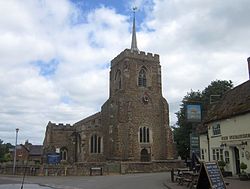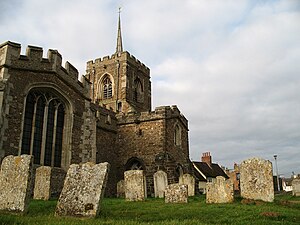Gamlingay
| Gamlingay | |
| Cambridgeshire | |
|---|---|
 St Mary's and the pub, Gamlingay | |
| Location | |
| Grid reference: | TL236526 |
| Location: | 52°9’28"N, 0°11’41"W |
| Data | |
| Population: | 3,535 |
| Post town: | Sandy |
| Postcode: | SG19 |
| Dialling code: | 01767 |
| Local Government | |
| Council: | South Cambridgeshire |
| Parliamentary constituency: |
South Cambridgeshire |
Gamlingay is a village in south-western Cambridgeshire, standing very close to the borders of both Huntingdonshire and Bedfordshire. It is 14 miles from Cambridge and had a recorded population in 2001 of 3,535.
Geography
Gamlingay is 14 miles west of the county town, Cambridge, and just five miles southeast of St Neots in Huntingdonshire. It is north of the village of Potton (Bedfordshire) and southwest of Waresley (Huntingdonshire).
Most of the central parish is on the Lower Greensand; the soil in the eastern part of the parish[1] is clay with gault subsoil.[2] Three nature reserves, Gamlingay Wood, Gamlingay Meadows and Gamlingay Cinques Common can be found in the parish,[3] the former and the latter being a Site of Special Scientific Interest and a County Wildlife Site respectively.
By the 12th century, heathland had developed on the Lower Greensand and the poor drainage of the soil there meant there were two quaking bogs, on Gamlingay Heath (drained in 1855) and Cinques Common. Treeplanting and pig rearing after inclosure in 1844 altered the landscape.[1]
In addition to Gamlingay village, the parish includes outlying areas named Gamlingay Cinques, Gamlingay Great Heath and Little Heath and the hamlet of Woodbury. | hamlet named Newton on the Heath had disappeared by 1279.[1]
Gamlingay Cirques
Gamlingay Cirques is a hamlet to the northwest of Gamlingay, lying along the south of Drove Road, which here forms the Huntingdonshire border. It is halfway between Gamlingay itself and Tetworth in the latter county.
Gamlingay Great Heath
Gamlingay Great Heath is a hamlet of Gamlingay lying a little off to the southwest, in the angle between Everton Road (the continuation of Drove Road) and The Heath. It is within Cambridgeshire still but right against the borders of Bedfordshire (Everton) and the detached part of Huntingdonshire encompassing much of Woodbury Hall Farm.
Churches

The parish church is St Mary the Virgin. It was built around the 12th century in the Early English style with a square tower (now containing eight bells) from field stones and local ironstone. Gamlingay is part of the parish of Gamlingay with Hatley St George and East Hatley.
A church existed in the parish before 1120.[1]
The village's first Baptist church was formed in 1670 and its first recorded minister was none other than John Bunyan, the author of the Pilgrim's Progress. In the beginning the church, which was originally known as Gamlingay Old Meeting, was a daughter congregation of Bunyan Meeting at Bedford, becoming independent in 1710. The meeting house was also built in 1710. It was rebuilt in 1840 and restored in 1881. The church was renamed Gamlingay Baptist Church in the 1990s and they continue to meet at 10.45 every Sunday.[4]
There was also an Anglican mission church at Gamlingay Heath dedicated to St Sylvester, originally constructed in iron in 1879, which closed in the 1980s.
A congregation of Particular Baptists worshipped at a chapel known as Zoar, built around 1800 at Gamlingay Cinques; it was demolished in the mid-1960s. A Primitive Methodist chapel was built at Green End in 1855.[1]
History
An village is listed in the Domesday Book of 1086 as Gamelingei, form the Old English for "Gamela's people's meadow".[5]
There has been occupation here since the middle Bronze Age and there are signs of occupation from the middle Stone Age. The village may have first been established around a central green south of the High Street (now known as Church Street); a complex of mediæval buildings stood at the east end of the green, but only a tithe barn and the house known as 'Emplins' remain today. Another focal point was provided by the crossroads at the other end of Church Street and houses spread to the south and east of the junction. In the 16th and 17th centuries, Gamlingay grew to the east towards Dutter End and west to Green End. By 1801, Gamlingay had a population twice as large as that of the hundred's second-largest parish, Bourn.[1]
Gamlingay is steeped in history, with many listed buildings in the village. The stone for building the church was from a quarry within the village. This quarry then offered the perfect location for an archery range. Being dug into the ground it was a safe area where archery could be practiced, and thus was named 'The Butts'. The Butts is now a children's play area.
Throughout history, Gamlingay has been a farming village. Most of the village was owned by Merton College in the University of Oxford, and Downing and Clare Colleges of the University of Cambridge. Until a few years ago, the local village college teamed its pupils into houses named after Merton, Downing and Clare.
In 1600, 64 houses- comprising much of the village[1] – were destroyed in the "Great Fire of Gamlingay", as described in an extract of a letter from the Privy Council to Sir Thomas Egerton:
"Whereas divers of the Justices of the Peace in the coutitie of Cambridge have certyfied us the lamentable accydent that bath fallen upon the inhabitantes of Gamlingay in the said countie, by casualltie of fire that happned on the 21St daie of Aprill last, whereby the moste parte of the said towne to the nomber of 76 houses with divers barnes and stackes of corne were suddainlie consumed."
By 1844, Gamlingay had five inns, including the Cock (dating from at least 1588), the Rose & Crown (1622) and the Blue Ball (1770s). The Sultan was built near the station in 1867.[1] At one time, there were 54 pubs in Gamlingay to serve the coach routes from London.
Gamlingay had a station on the "Varsity Line"; the Bedford and Cambridge branch of the London and North Western Railway,[2] which opened in 1862 and shut in 1968 in the Beeching cuts.[6]
Economy
Gamlingay is now largely a commuter village: about half of its employed residents work outside Cambridgeshire.
Farming, mainly arable, was the primary employer in Gamlingay for many centuries. A third of the parish was cultivated in 1801, with wheat the main crop, then barley and peas. In 1937, there were 12 smallholders and 11 market gardeners. There was some gravel extraction south of the village in the late 19th century; in 1864 the village had three brickworks. In 1912, one occupied an area of 31 acres, with 12 kilns and a warehouse capable of holding 500,000 bricks. The closure of the brick and tile works probably caused the parish's population to fall in the after its sale in 1920.[1]
Sights of the village

A war memorial, built from Cornish granite, stands outside Gamlingay Village College and commemorates men from the village who died in the First and Second World Wars.[7]
Two timber-framed buildings in the village date from the late 15th or early 16th centuries: Emplins,[8] a large house near the church, and Merton Manor Farm.[1]
A total of 60 buildings in Gamlingay parish are listed, including the Baptist chapel on Stocks Lane,[9] Merton Grange,[10] the Cock Inn,[11] a red telephone box outside the church,[12] and many buildings along Church Street.
Transport
The B1040 road runs through Gamlingay from Potton to the A14 near Hilton. Minor roads lead to Hatley, Everton and Little Gransden. The nearest railway station is at Sandy in Bedfordshire.
Big Society
Local amenities include pubs, shops, sports fields, a community centre, clubs and societies, nursery schools and a Grade II listed telephone box.
Gamlingay is also home to Gamlingay Eco Hub[13] and has its own community music charity, Gamlingay Records.[14]
References
- ↑ 1.00 1.01 1.02 1.03 1.04 1.05 1.06 1.07 1.08 1.09 A History of the County of Cambridge and the Isle of Ely: Volume 5; Parishes: Gamlingay' (1973), pp. 68-87
- ↑ 2.0 2.1 Information on Gamlingay from GENUKI
- ↑ "A to Z list of Wildlife Trust nature reserves". The Wildlife Trusts. Archived from the original on 30 January 2014. http://www.webcitation.org/6N17gVH3E. Retrieved 30 January 2014.
- ↑ "GamlingayBaptistChurch". http://www.gamlingaybaptist.btck.co.uk/Home. Retrieved 2010-08-17.
- ↑ Mills, A.D. (1998). A Dictionary of English Place-names. Second Edition. Oxford University Press, Oxford. p147. ISBN 0-19-280074-4
- ↑ Subterranea Britannica: Gamlingay Station
- ↑ Roll of Honour: Gamlingay
- ↑ National Heritage List 1309190: The Emplins
- ↑ [National Heritage List 1128151: Baptist Chapel, Stocks Lane
- ↑ National Heritage List 1128150: Merton Grange, Station Road
- ↑ National Heritage List 1330904: Cock Inn
- ↑ National Heritage List 1330923: Telephone Kiosk, Church Street
- ↑ "Gamlingay Eco Hub". http://www.eco-hub.info/. Retrieved 20 November 2013.
- ↑ "Gamlingay Records". http://www.gamlingayrecords.co.uk. Retrieved 20 November 2013.
- James Brown, Gamlingay: Six Hundred Years of Life in an English Village (London: Cassell, 1989)
- James Brown, Villagers: 750 Years of Life in an English Village (Amberley Publishing, 2011)
Outside links
| ("Wikimedia Commons" has material about Gamlingay) |
